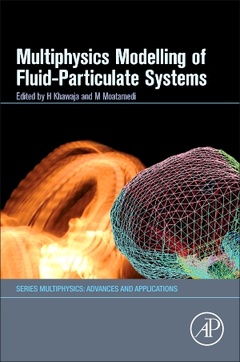Description
Multiphysics Modelling of Fluid-Particulate Systems
Multiphysics: Advances and Applications Series
Coordinators: Khawaja Hassan, Moatamedi Mojtaba
Language: English
Subjects for Multiphysics Modelling of Fluid-Particulate Systems:
Keywords
application; application examples; automotive; bubbles; bubbling regime; CFD; CFD-DEM; computational fluid dynamics; damping; DEM; digitalization; dirt particle distribution-detection; discrete element model; filer fiber analysis; filter fiber engineering; filtration; filtration efficiency; fitted functions; fluidization; fluidized beds; fluid?particle interactions; four-way coupling; hypervelocity impact; introduction; kd trees; large particles; multimaterial arbitrary Lagrangian Eulerian; multiphase; neighbors search; nonspherical particles; oil-filter; OpenFOAM; overview; parallelization; particle penetration; pressure fluctuations; reconstruction algorithm; shock tube; shock waves; six degrees of freedom; smoothed particle hydrodynamics; smoothing kernel; solver validation; sound waves; speed of sound; spherical particles; structure of part 2; undex explosion; variable smoothing length; volume average equations
438 p. · 15x22.8 cm · Paperback
Description
/li>Contents
/li>Readership
/li>Biography
/li>Comment
/li>
Multiphysics Modelling of Fluid-Particulate Systems provides an explanation of how to model fluid-particulate systems using Eulerian and Lagrangian methods. The computational cost and relative merits of the different methods are compared, with recommendations on where and how to apply them provided. The science underlying the fluid-particulate phenomena involves computational fluid dynamics (for liquids and gases), computational particle dynamics (solids), and mass and heat transfer. In order to simulate these systems, it is essential to model the interactions between phases and the fluids and particles themselves. This book details instructions for several numerical methods of dealing with this complex problem.
This book is essential reading for researchers from all backgrounds interested in multiphase flows or fluid-solid modeling, as well as engineers working on related problems in chemical engineering, food science, process engineering, geophysics or metallurgical processing.
Part 1 Computational Fluid Dynamics: Discrete Element Modeling of Fluidized Beds 1. Introduction: discrete element modeling-computational fluid dynamics of fluidized beds 2. Methodology: CFD-DEM of Fluidized Beds 3. Validation case study: bubbling in the fluidized bed 4. Validation Case Study: Sound Waves in Fluidized Medium
Part 2 Large, (non)spherical particle modeling in the context of fluid filtration applications (resolved Eulerian-Lagrangian) 5. Introduction: large, (non-)spherical particle modeling in the context of fluid filtration applications 6. Methodology: large (non)spherical particle modeling in the context of fluid filtration applications 7. Validation: experimental and semianalytical 8. Application and results: filter fiber engineering 9. Conclusion and vision
Part 3 Lagrangian-Lagrangian: Modeling Shocks through Inhomogeneous Media with Smoothed Particle Hydrodynamics 10. Introduction: smoothed particle hydrodynamics modeling of shocks 11. Methodology: smoothed particle hydrodynamics modeling of shocks 12. Validation: smoothed particle hydrodynamics modeling of shocks 13. Conclusion: smoothed particle hydrodynamics modeling of shocks
Professor Moatamedi is President of The International Society of Multiphysics, as well as an Executive Director for New York University London. Prior to this, he was a President for Al Ghurair University, and has held senior managerial positions at Imperial College London, Narvik University College, Cranfield University, The University of Salford and The University of Sheffield. He is Editor-in-Chief of ‘Th
- Provides detailed coverage of Resolved and Unresolved Computational Fluid Dynamics - Discrete Element Method (CFD-DEM), Smoothed Particle Hydrodynamics, and their various attributes
- Gives an excellent summary of a range of simulation techniques and provides numerical examples
- Starts with a broad introduction to fluid-particulate systems to help readers from a range of disciplines grasp fundamental principles




